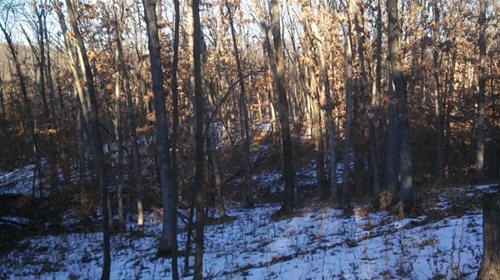There’s no more football to watch, so I’m sure most of you property managers out there are now hard at work on your timber improvement projects. February, as we all know, is one of the best times to perform the girdling, hacking-and-squirting, and tree felling necessary to improve the wildlife productivity and future profitability of your timber stands.
Considering that such a large portion of Missouri is covered with trees, I’m sure there is no need to inform people about the tremendous wildlife value of chopping down some trees, right?…Right? Look to the right. If your woods look as thick as this, it’s time to talk forest management.
Here is an example of a stand that could use some thinning:

Quail Forever biologists have the privilege to visit hundreds of farms each year, draft management plans, help with cost share, and walk hand in hand with landowners as they travel towards better conservation practices on their property. Timber management is often categorically overlooked as a management technique for holding more quail and other wildlife.
Common misconceptions I hear from landowners who haven’t considered active timber management on their property:
- Timber does not need management to perform to its fullest for wildlife–let Mother Nature take her course, and don’t mess with it.
- I hunt deer, so I should never cut an oak. Doing so will reduce the amount of hard mast available, and my deer herd and turkey flock will suffer.
- By not touching my timber stands, I am creating a cash windfall in 40 years when my children or grandchildren can finally harvest the beautiful, massive logs I left for them.
There are many more misconceptions about timber management than these, but this combination of misinformation seems to lead many landowners to look at their timber and turn the other way.
Here are some truths:
- If timber accounts for 50 percent of your property, ignoring it is ignoring game management on half your potential habitat. We no longer live in a world where natural processes can keep timber managed—invasive plants, lack of landscape-clearing fires, and high-grading clear cuts now necessitate the need for intervention in most stands.
- If you are hesitant to cut a single tree in a stand of oaks and hickories, keep in mind that a 1991 study in Oklahoma showed that 8 percent of a deer’s annual food intake was acorns, and 85% was browse and forbs (the sort of stuff that grows when sunlight breaks through tree canopies following harvests).
- Without occasional management, the growth of marketable or wildlife friendly trees is severely restricted. You may be leaving your children more of a chore than a profitable piece of timber!
What you can do:
Start with small and impactful projects, such as including a woody draw in a larger prescribed fire. Removal of noxious woody plants like bush honeysuckle, russian olive, and cedars can keep the ball rolling. Especially on southern oriented slopes, extraordinary quail habitat can be created with a timber thinning and burn—often with no need to reseed!
Think you’re ready to dive right in? Speak with a Quail Forever or Missouri Department of Conservation biologist to get started on a professionally developed Forest Management Plan!
Scott Engelman is a Quail Forever Farm Bill wildlife biologist in Missouri. Quail Forever Farm Bill wildlife biologists provide landowners sound advice and assistance regarding conservation practices and wildlife habitat improvements.